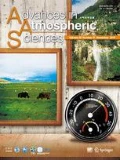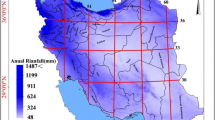Abstract
Rainfall is a highly variable climatic element, and rainfall-related changes occur in spatial and temporal dimensions within a regional climate. The purpose of this study is to investigate the spatial autocorrelation changes of Iran’s heavy and super-heavy rainfall over the past 40 years. For this purpose, the daily rainfall data of 664 meteorological stations between 1971 and 2011 are used. To analyze the changes in rainfall within a decade, geostatistical techniques like spatial autocorrelation analysis of hot spots, based on the Getis-Ord Gi statistic, are employed. Furthermore, programming features in MATLAB, Surfer, and GIS are used. The results indicate that the Caspian coast, the northwest and west of the western foothills of the Zagros Mountains of Iran, the inner regions of Iran, and southern parts of Southeast and Northeast Iran, have the highest likelihood of heavy and super-heavy rainfall. The spatial pattern of heavy rainfall shows that, despite its oscillation in different periods, the maximum positive spatial autocorrelation pattern of heavy rainfall includes areas of the west, northwest and west coast of the Caspian Sea. On the other hand, a negative spatial autocorrelation pattern of heavy rainfall is observed in central Iran and parts of the east, particularly in Zabul. Finally, it is found that patterns of super-heavy rainfall are similar to those of heavy rainfall.
摘 要
降水是一项非常灵活多变的气候影响因素, 而降水相关时空演变发生在区域气候尺度上. 本文旨在调研伊朗过去 40 年暴雨和特大暴雨空间自相关变化特征. 基于此研究目的, 使用了 1971–2011 年 664 个气象台站日降水资料. 为分析每个十年内的降水变化规律, 应用了基于 Getis-Ord Gi统计识别(简称G指数)热点分析法的空间自相关分析地质统计学技术, 以及 MATLAB 科学计算语言, Surfer 绘图软件和地理信息系统(GIS). 结果显示: 里海沿岸, 伊朗扎格罗斯山脉西侧山麓西北部和西部地区, 伊朗内陆区域, 以及伊朗东南和东北的南部地区, 均为暴雨和特大暴雨最高频发地带. 从暴雨空间分布可见, 尽管在不同时间段暴雨高频发区位置有所振荡, 暴雨空间自相关正极大值区域包括了里海西侧和西北侧海岸, 而负极大值区域位于伊朗中部和东部部分地区, 特别是扎布尔省. 进一步研究发现, 特大暴雨空间自相关格局分析结果, 与暴雨结果类似.
Similar content being viewed by others
References
Ahmedou, O. C. A., H. Yasuda, K. Wang, and K. Hattori, 2008: Characteristics of precipitation in northern Mauritania and its links with sea surface temperature. Journal of Arid Environments, 72, 2243–2250, doi: 10.1016/j.jaridenv.2008.07.011.
Alexander, L. V., and Coauthors, 2006: Global observed changes in daily climate extremes of temperature and precipitation. J. Geophys. Res., 111, D05109, doi: 10.1029/2005JD006290.
Alijani, B., 1996: The Climate of Iran. Payam Noor University Press, 221 pp.
Alijani, B., 2002: Identification of Tehran rainy weather types are calculated based on volubility. Geographical Research Quarterly, 114–132. (In Persian)
Alijani, B., 2011: Spatial analysis of critical temperatures and daily precipitation in Iran. Journal of Geographical Sciences and Applied Research, 20, 9–30. (In Persian)
Alijani, B., M. Doostkamyan, A. Bayat, Y. Balyani, and A. Javanmard, 2013: Analysis of precipitation in Iran. Proc. Second International Conf. Environmental Hazards, Khuarazmi University Press, 220–231. (In Persian)
Ashjaie Bashkand, M., 2000: Analysis of Synoptic Model of Heavy Precipitation in the North West of Iran, Faculty of Sciences. Tarbiat Modarres University, 120 pp. (In Persian)
Azizi, G., M. Niri, and S. Rostami Khalilian, 2009: Synoptic Analysis of heavy precipitation rainfall in the West Country Case Study: Period from 7 to 14 March, 2005. Physical Geography, 1–13. (In Persian)
Bozkurt, D., and O. L. Sen, 2011: Precipitation in the Anatolian Peninsula: sensitivity to increased SSTs in the surrounding seas. Climate Dyn., 36, 711–726, doi: 10.1007/s00382-009-0651-3.
Bradford, J. M., J. E. Ferris, and P. A. Remley, 1987: Interrill soil erosion processes: I. Effect of surface sealing on infiltration, runoff, and soil splash detachment. Soil Science Society of America Journal, 51, 1566–1571, doi: 10.2136/sssaj1987.03615995005100060029x.
Chen, C.-S., C.-Y. Lin, Y.-J. Chuang, and H.-C. Yeh, 2002: A study of afternoon heavy rainfall in Taiwan during the meiyu season. Atmos. Res., 65, 129–149, doi: 10.1016/S0169-8095(02)00061-3.
Dimitrova, T., R. Mitzeva, and A. Savtchenko, 2009: Environmental conditions responsible for the type of precipitation in summer convective storms over Bulgaria. Atmospheric Research, 93, 30–38, doi: 10.1016/j.atmosres.2008.10.010.
Faraj Zadeh, M., and S. Rajai Najaf Abadi, 2013: Analysis of synoptic conditions, heavy precipitation events in a flood (city Koohrang). Research Journal of Geography and Planning, 45, 143–162. (In Persian)
Griffith, D. A., 1992: What is spatial autocorrelation? Reflections on the past 25 years of spatial statistics. Espace Géographique, 21, 265–280.
Groisman, P. Y., and Coauthors, 1999: Changes in the probability of heavy precipitation: important indicators of climatic change. Climatic Change, 42, 243–283, doi: 10.1023/A:1005432803188.
IPCC, 2014: Climate Change 2014–Impacts, Adaptation and Vulnerability: Part B: Regional Aspects. Cambridge University Press, Cambridge.
Jansa, A., A. Genoves, M. A. Picornell, J. Campins, R. Riosalido, and O. Carretero, 2001: Western Mediterranean cyclones and heavy rain. Part 2: Statistical approach. Meteorological Applications, 8, 43–56, doi: 10.1017/S1350482701001049.
Kato, T., and K. Aranami, 2005: Formation Factors of 2004 Niigata-Fukushima and fukui heavy rainfalls and problems in the predictions using a cloud-resolving model. SOLA, 1, 1–4, doi: 10.2151/sola.2005-001.
Kaviani, M. R., and B. Alijani, 2001: Principles of Climatology. SAMT Press, 582 pp. (In Persian)
Kawabata, T., H. Seko, K. Saito, T. Kuroda, K. Tamiya, T. Tsuyuki, Y. Honda, and Y. Wakazuki, 2007: An assimilation and forecasting experiment of the nerima heavy rainfall with a cloudresolving nonhydrostatic 4-Dimensional variational data assimilation system. J. Meteor. Soc. Japan., 85, 255–276, doi: 10.2151/jmsj.85.255.
Lana, A., J. Campins, A. Genovés, and A. Jansà, 2007: Atmospheric patterns for heavy rain events in the Balearic Island s. Adv. Geosci., 12, 27–32, doi: 10.5194/adgeo-12-27-2007.
Lashkari, H., 2001: Synoptic patterns of heavy precipitation in south western Iran, geography. Tarbiat Modarres University, 163 pp. (In Persian)
Lenderink, G., E. Van Meijgaard, and F. Selten, 2009: Intense coastal rainfall in the Netherland s in response to high sea surface temperatures: analysis of the event of August 2006 from the perspective of a changing climate. Climate Dyn., 32, 19–33, doi: 10.1007/s00382-008-0366-x.
Lin, Y.-L., S. Chiao, T.-A. Wang, M. L. Kaplan, and R. P. Weglarz, 2001: Some common ingredients for heavy orographic rainfall. Wea. Forecasting, 16, 633–660, doi: 10.1175/1520-0434 (2001)016<0633:SCIFHO>2.0.CO;2.
Masoudian, S. A., 2009: Iran’s rainfall area. Geography and Development, 13, 79–91. (In Persian)
Messager, C., H. Gallée, and O. Brasseur, 2004: Precipitation sensitivity to regional SST in a regional climate simulation during the West African monsoon for two dry years. Climate Dyn., 22, 249–266, doi: 10.1007/s00382-003-0381-x.
Mofidi, A., and A. Zarrin, 2005: The synoptic study of low pressure systems of the Sudan in heavy rain falls in Iran. Geographical Research, 22, 113–136. (In Persian)
Mohammadi, B., and S. A. Masoudian, 2010: Synoptic analysis of heavy precipitation in Iran Case Study November 1994. Geography and Development, 19, 47–70. (In Persian)
Montazeri, M., 2009: Tempo-spatial analysis of extreme 24 hour precipitations in Iran. Journal of Geography and Environmental Planning, 20, 125–140. (In Persian)
Moradi, H. R., 2002: synoptic analysis of the precipitation on southern coast of caspian sea in six cold months of years. Iranian Journal of Marine Sciences and Technology, 21, 61–72. (In Persian)
Nouri, H., H. Ghayour, A. Masoodian, M. Azadi, and A. Ildoromi, 2013: The effect of sea surface temperature and 2m air temperature on precipitation events in the southern coasts of Caspian Sea. Ecopersia, 1, 369–383. (In Persian)
Nouri, H., H. A. Ghayoor, S. A. Masoudian, and M. Azadi, 2012: Clouds analysis in heavy and super heavy precipitations in the southern coasts of Caspian Sea. Journal of Geography and Environmental Planning, 23, 1–22. (In Persian)
Omidvar, K., M. Mahmodabadi, and F. Safarpoor, 2015: A synoptic analysis of heavy rains February 2011 in southern and central regions of Iran (with emphasis on Kerman Province). Geography and Planning, 9, 21–39. (In Persian)
Pastor, F., J. A. Valiente, and M. J. Estrela, 2015: Sea surface temperature and torrential rains in the Valencia region: modelling the role of recharge areas. Natural Hazards and Earth System Science, 15, 1677–1693.
Pielke, R. A., and M. W. Downton, 2000: Precipitation and damaging floods: Trends in the United States, 1932–97. J. Climate, 13, 3625–3637, doi: 10.1175/1520-0442(2000)013 <3625:PADFTI>2.0.CO;2.
Qashqai, G., 1996: Effect of Siberian high pressure winter precipitation on the southern coast of the Caspian Sea, Geography, Khouarazmi University, 107 pp. (In Persian)
Römkens, M. J. M., K. Helming, and S. N. Prasad, 2002: Soil erosion under different rainfall intensities, surface roughness, and soil water regimes. Catena, 46, 103–123.
Rousta, I., F. K. Akhlagh, M. Soltani, and S. M. Taheri, 2014: Assessment of blocking effects on rainfall in northwestern Iran. Proc. 12th International Conf. Meteorology, Climatology and Atmospheric Physics, M. Kanakidou et al., Eds., COMECAP2014, 1 ed., Crete University Press., Greece, 291 pp.
Rousta, I., M. Soltani, W. Zhou, and H. H. Cheung, 2016a: Analysis of extreme precipitation events over central Plateau of Iran. American Journal of Climate Change, 5, 297–313, doi: 10.4236/ajcc.2016.53024.
Rousta, I., M. Doostkamian, E. Haghighi, and B. Mirzakhani, 2016b: Statistical-synoptic analysis of the atmosphere thickness pattern of iran’s pervasive frosts. Climate, 4(3): 41, doi: 10.3390/cli4030041
Salehvand, I., H. Atai, M. Moemeni, and M. Montazeri, 2014: The study of atmospheric movement patterns and its effect on heavy rainfalls in Iran: Case study (January 6th of 1998). Scientific Journal of Pure and Applied Sciences, 3, 906–913. (in Persian)
Soltani, M. I. Rousta, S. M. Taheri, 2013: Using mann-kendall and time series techniques for statistical analysis of long-term precipitation in Gorgan weather station. World Applied Sciences Journal, 28, 902–908. doi: 10.5829/idosi.wasj.2013.28.07.946
Soltani, M., I. Rousta, F. K. Akhlagh, S. M. Taheri, 2014b: Statistical synoptic analysis of summertime extreme precipitation events over Kerman province. 12th International Conference on Meteorology, Climatology and Atmospheric Physics, M. Kanakidou et al., Eds., COMECAP 2014, 1 ed., Crete University Press, Greece, 291 pp.
Soltani, M., and Coauthors, 2016: Assessment of climate variations in temperature and precipitation extreme events over Iran. Theor. Appl. Climatol., 126, 775–795, doi: 10.1007/s00704-015-1609-5.
Soltani, M., M. Molanejad, F. Khoshakhlagh, A. R. SaadatAbadi, and F. Ranjbar, 2014a: Synoptic and thermodynamic characteristics of 30 March–2 April 2009 heavy rainfall event in Iran. Meteorology and Atmospheric Physics, 126, 49–63, doi: 10.1007/s00703-014-0339-z.
Sotodeh, F., and B. Alijani, 2015: The Relationship between Spatial Distribution of Heavy Precipitation and Pressure Patterns in Guilan Province. Journal of Spatial Analysis Environmental Hazarts, 2, 63–73. (In Persian)
Tabari, H., H. Abghari, and P. H. Talaee, 2012: Temporal trends and spatial characteristics of drought and rainfall in arid and semiarid regions of Iran. Hydrological Processes, 26, 3351–3361. (In Persian)
Wischmeier, W. H., and D. D. Smith, 1958: Rainfall energy and its relationship to soil loss. EOS, Transactions American Geophysical Union, 39, 285–291, doi: 10.1029/TR039i002p00285.
Acknowledgements
The authors would like to thank the Iran Meteorological Organization for providing the meteorological data for this study.
Author information
Authors and Affiliations
Corresponding author
Rights and permissions
About this article
Cite this article
Rousta, I., Doostkamian, M., Haghighi, E. et al. Analysis of spatial autocorrelation patterns of heavy and super-heavy rainfall in Iran. Adv. Atmos. Sci. 34, 1069–1081 (2017). https://doi.org/10.1007/s00376-017-6227-y
Received:
Revised:
Accepted:
Published:
Issue Date:
DOI: https://doi.org/10.1007/s00376-017-6227-y




